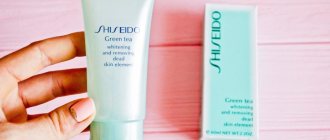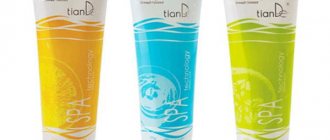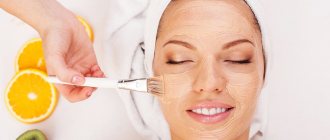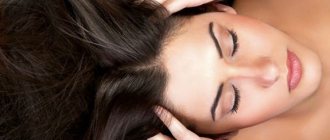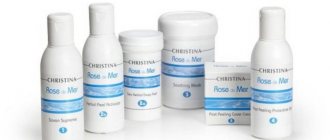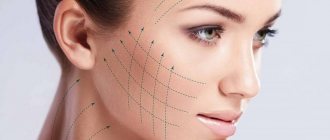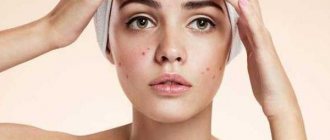| Shirokova O.A. Dermatocosmetologist, specialist in laser and injection techniques |
Autumn is associated with bad weather, rain and rare sunshine, but this weather allows many cosmetic procedures, including various peelings, to be carried out without undesirable consequences.
After summer, the skin often needs exfoliation, which will help improve the quality of the skin, refresh it, make it more radiant and even in color. Peels: chemical and laser help to achieve such effects.
Chemical and laser peels - what are they?
Chemical peeling involves applying solutions with a certain acidity to superficially exfoliate the skin. It is recommended to do either a superficial or a mid-level chemical peel, as the deep type of chemical peel can be very damaging to the skin and the recovery period is very long - the skin may not recover optimally.
Laser peeling is exposure to a light beam aimed at evaporating water. In this case, exfoliation occurs because skin cells are sloughed off by removing water from them.
Types of chemical plings
Chemical peels are classically divided into 3 categories based on the depth of skin exfoliation. However, confusion often arises because the depth of peel penetration and potential peeling depends on a number of factors and do not always correlate.
To objectively understand the mechanism of operation of chemical peels, we suggest considering them taking into account two main characteristics :
- Penetration lip
- Composition of active substances
Types of laser peelings by depth of impact
Laser peels are superficial, medium and fractional.
Superficial peels are aimed at refreshing the skin, removing shallow age spots acquired over one or two seasons, unevenness and dull complexion.
Medium peels penetrate deeper into the reticular layer of the dermis. This procedure is aimed at correcting wrinkles, scars and skin creases, so it is quite active and requires a long rehabilitation period - from 5 to 10 days.
Fractional laser thermolysis was an excellent alternative to laser resurfacing and deep chemical peels, after which the skin was significantly injured, and the rehabilitation period could take a month. Laser thermolysis is a more gentle way to get rid of serious and deep skin problems.
With fractional thermolysis, unlike laser resurfacing, the effect is carried out not by a spot of light, but by a beam of small scattering rays. This procedure is less traumatic, which means the rehabilitation period will be shorter.
Bio-RePeel
During this procedure, a biphasic stimulator is used. This means that old cells are gently exfoliated, the process of active biosynthesis is launched, and as a result the skin is renewed. Girls aged 18 and above can afford this peeling. It all depends on what problem needs to be solved: acne or age-related changes. Only the method of application and the time of exposure change, but only a professional cosmetologist knows these subtleties.
Pros. Allows you to gain clearer facial features, achieve a long-lasting lifting effect, and increase skin elasticity. In addition, the skin is cleansed and renewed, and the complexion becomes more even. Thanks to amino acids, after this procedure the effect of hydration and rejuvenation is especially noticeable.
Laser or chemical peeling - what's the difference?
The question often arises: what is the difference between chemical and laser peels, if they both focus on exfoliation? The thing is that we are all different, and everyone requires an individual approach at different times.
The advantage of chemical peels is that they are seasonal, performed quickly and without discomfort. However, the skin is a porous organ, so the chemical composition may penetrate into it unevenly, and it will not always be possible to control its distribution and effect on certain areas.
With laser peeling, on the contrary, an important advantage is control of the depth of exposure.
Peeling penetration depth
The penetration depth of the peel depends on the following factors:
- Acid concentration;
- Number of layers applied;
- Thickness and type (oily, dry, normal) of skin.
Depending on the depth of penetration into the skin, chemical peels are classically divided into 3 categories:
SUPERFICIAL PEELING – to the germinal layer of the epidermis (to the epidermal-dermal junction).
• Glycolic acid 30 – 50%
• Lactic acid 10 – 30%
• Mandelic acid 40%
• Salicylic acid up to 30%
• Pyruvic acid up to 50%
Possible complications : post-inflammatory pigmentation, erythema, itching, burning, superficial exfoliation/epidermolysis.
MEDIUM PEELING – the entire thickness of the epidermis to the papillary layer of the dermis.
• Salicylic acid more than 30%, multi-layer application
• Glycolic acid 70%
• TCA 30 – 50%
Possible complications : post-inflammatory pigmentation, secondary infection, scars, acne rashes, abundant and deep exfoliation.
DEEP PEELING – up to the reticular layer of the dermis.
• TCA more than 50% (single-layer application)
• Phenol peeling
Possible complications : in addition to those that occur with mid-peelings, cardiotoxicity, arrhythmia, hepato- and nephrotoxicity are possible.
The complications listed above justify the cosmetologist’s task - to achieve results while minimizing the risks of a difficult post-peeling period.
It is important to remember that traumatic medium and deep peels are not needed in every situation!
Read about what gel peeling is, how to use it, what types there are and for what skin, and what is the difference between home and professional formulations here .
How to choose peeling?
The type of peeling is selected by a cosmetologist individually for the patient - in accordance with the skin type and its problems.
For mild to moderate acne, chemical superficial peels are quite suitable, as they have a sebum-regulating effect and a slight exfoliating effect - this is exactly what is needed to restore skin with acne.
To combat shallow wrinkles - medium chemical or laser peels. For post-acne scars, deep wrinkles or creases, laser treatment should be considered.
Features and rules of care after Jessner peeling
To achieve the desired effect, it is important not only to the quality of the procedure, but also to proper care after peeling. To do this, the cosmetologist explains in detail to the client the step-by-step procedure, with recommended products and preparations for caring for the skin condition.
- Be sure to strictly follow the recommendations and instructions of the cosmetologist.
- After peeling, it is unacceptable to wash your face for 12 hours.
- Usually, a cosmetologist individually selects a set of products for intensive moisturizing and gradual restoration of the skin - the most important point for the desired effect, which should not be neglected.
- Only boiled water is suitable for washing; the surface of the skin should be wiped with blotting movements.
- You should temporarily abandon standard cosmetics and homemade masks. The bet should be made in favor of restorative, wound-healing creams and serums.
- The option of sunbathing is unacceptable; you can walk outside only if you apply a UV filter to your face with a high protection factor.
Rehabilitation period after peelings
The recovery period after chemical peels varies: with superficial peeling it is literally 2-3 days of tightness and slight peeling without much discomfort.
After laser procedures, recovery will be longer - from 3 to 7 days. This is due to the deeper impact and skin area covered. After all the crusts and peeling disappear, the skin will become smooth and beautiful.
Of course, everything is individual, and the skin may react differently: there may be redness, peeling immediately after the procedure, and itching. In these cases, it is important to remember that these are temporary changes that will not affect the final result, but they require careful care and contact a specialist.
Jessner peeling is carried out in two levels. The procedure can be median or superficial:
- Superficial - the procedure is based on applying only one layer of solution, keeping it on the surface for a short time to ensure deep penetration into the composition of the epidermis. As a rule, a procedure is performed to prepare the skin for medium peels. The skin after the superficial procedure does not imply significant peeling.
- The middle procedure is working with three or more amounts of solution. In this case, the skin after peeling begins to turn red, the next day it completely acquires a brown tint, covered with a crust or film, with tightening, with severe peeling and flaking after a few days.
Contraindications to peelings
Are there any contraindications to chemical and laser peels?
Of course, there are restrictions: cosmetic peelings are not recommended for pregnant women, nursing mothers, cancer patients and people with autoimmune skin diseases.
Also, neither laser nor chemical peels are recommended before trips to active sun, due to the possibility of hyperpigmentation. It is important to remember that the skin will be completely restored and ready for sunbathing in 2-3 weeks.
The modern trend is people without age and eternal youth. Hardware techniques are ready to help you with this! Be active, healthy and beautiful!
You have chosen a gentle peeling
Or rather, a gentle peeling has been chosen for you if you are carrying out the procedure in a salon. Let us explain why this happens.
Aesthetic medicine, which tries to make a woman young and beautiful regardless of age, does not have standard solutions or universal recipes. The specialist (if he is a professional) will definitely take into account all the individual characteristics of the client.
The first visit to the salon for chemical facial cleansing always involves a gentle procedure. This is why there is no peeling after peeling.
The second position - products based on glycolic and fruit acids were used. Such procedures are classified as superficial; they do not affect the deep layers of the epidermis (and even more so do not affect the dermal tissues). The peeling of dead cells can be so slight that it is simply not visible to the naked eye.
The third position is a modern modified exfoliant. The products are designed in such a way that they do not have an aggressive effect on the skin, but remain no less effective. Therefore, there will be no peeling.
Prices:
Peelings
| TCA peeling (Easy TCA Peel) 70% | 12,000 rub. |
| TCA peeling (Easy TCA Peel) 50% | 10,000 rub. |
| TCA peeling (Easy TCA Peel) 25% | 8,000 rub. |
| TCA peeling (Easy TCA Peel) 15% | 6,000 rub. |
| Retinol yellow peeling (Timeless Peel/Lightening Cream) – face | 5,000 rub. |
| Retinol yellow peeling (Timeless Peel/Lightening Cream) – face, neck | 7,500 rub. |
| Retinol orange peeling (Purity Peel) | 4,000 rub. |
| Blue Peel | 4,000 rub. |
| Peeling PRX-T33 – face | 5,000 rub. |
| Peeling PRX-T33 – face + neck | 7,500 rub. |
| Peeling PRX-T33 – face+neck+décolleté | 9,000 rub. |
| ENERPEEL JR (Jessner Peel) | 5,000 rub. |
Face cleaning
Peeling has already passed
The absence of unpleasant dry flakes, which scare women the most, is possible not only when performing facial peeling with a gentle composition for the first time.
Women who regularly take care of their appearance and carry out cosmetic procedures in a salon or at home achieve amazing results. That is, the keratinized skin particles are so small, and the epidermis itself is pliable and susceptible to influence, that the upper dead layer is removed when the working composition is removed. Consequently, during the post-peeling period, skin peeling is not observed at all, or is very mild.
What will cosmetologists say?
Experts say that those with oily skin types most often report a lack of peeling after chemical peeling. The reason is simple - the sebaceous secretion binds the keratinized particles and they either “fly off” during the removal of the composition, or a more thorough cleansing is required with a repeat procedure at least two weeks later.
After yellow peeling, there is no peeling in people with special skin types (we have already talked about them). Also, a similar reaction can be observed if the treatment is not retinoic (using retinoic acid), but retinol (using vitamin A and its natural derivatives). The second option is softer, more gentle, providing only a superficial effect on the epidermis. But it is less effective.
Salicylic peels may also not cause peeling in people with oily skin or low acid concentrations. Although this type of procedure is considered a very good preparation before more aggressive influences. Salicylic acid in the composition of the product very well loosens the upper stratum corneum. However, the manipulation needs to be done a week and a half before the “heavy artillery”.
Detachment of epithelial cells occurs imperceptibly when using the “correct” cosmetic products in the post-peeling period and following post-care rules.
Even if the skin does not peel off, cosmetologists advise:
- wash your face after chemical exfoliation with any composition the next morning. For these purposes, it is recommended to use cleansers with a neutral pH (not soap! – it dries). Thermal water or regular mineral water without gas will do;
- Do not use decorative cosmetics for 3-4 days. The effect of peeling will be more pronounced;
- during the entire rehabilitation period (the full recovery cycle ranges from 7 to 14 days) do not use scrubs, other peelings, alcohol-based tonics, cleansing wipes and similar products;
- also during this time do not visit places with high temperature and humidity - saunas, baths, swimming pools, beaches;
- do not sunbathe in the sun or go to the solarium for at least a month;
- even in winter, before going outside, apply a protective cream with a UV factor of at least 30 to your face;
- For the first three days, lubricate your face with panthenol-based creams at night. Next, regularly use moisturizers in the morning and nourishing products at night. Select caring cosmetics according to skin type and age.
Note. Cosmetologists recommend doing chemical peels during the season of least solar activity - from October to April. The sun can provoke the appearance of even greater pigmentation if you do not use sunscreen, or the protection index is insufficient.

